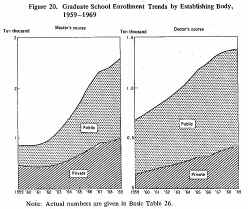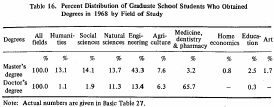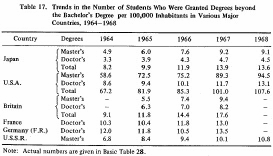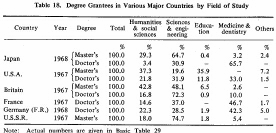| Home > Policy > White Paper, Notice, Announcement > White Paper > EDUCATIONAL STANDARDS IN JAPAN 1971 > CHAPTER |
||
Graduate schools are organized separately from undergraduate faculties, and include master's and/or doctor's courses. As of 1969, l75'universities (58 national, 17 local public and 100 private) had graduate schools. This is 46% of all the 379universities. In 1959,there were only 78 such universities.
Graduate school enrollment has been steadily increasing, reaching 26,000 in master's courses and 14,000 in doctor's courses in 1969,'a rate of increase since1959 of 3 times and 2 times respectively. Sixty-one percent of the students in master's courses and 69% of the students in doctor's courses are enrolled in public institutions.

Note: Actual numbers are given Basic Table 26. Basic Table 26
The distribution of graduate school students who obtained degrees in 1968, by field of study is as shown in Table l 6.Graduate schools are set up in Japan, the U.S.A. Britain and the U.S.S.R., but in France and West Germany, no system of graduate schools exists. However, the third cycle of French universities, i.e., advanced courses for those students who have completed four years of a university course can be regarded as equivalent to graduate schools. Master's and doctor's degrees are granted to those who have finished such advanced courses. In West Germany, university graduates can be granted doctor's degrees on' the basis of a dissertation evaluation, but master's degrees arc non-existent.
The number of students who were granted degrees beyond the bachelor's degree, per 100,000 inhabitants, from 1964 to 1968 in various major countries is shown in Table 17.

Note: Actual numbers are given in Basic table 27. Basic Table 27

Note: Actual numbers are given in Basic Table 28. Basic Table 28
In terms of the number of those who were granted degrees beyond the bachelor's degree, per 100,000 inhabitants in 1967, Japan is exceeded by the U.S.A. and Britain. The annual rate of increase in this number is remarkable in all of the major countries, since it exceeds that of the rate of increase in the total enrollment in higher educational institutions. This is due to the fact that in all the major countries strenuous efforts have been made in recent years to expand education at the graduate school level. The ratios of master's degree grantees to doctor's degree grantees in Japan, the U.S.A. and Britain has recently been approximately 2 to 1, 9 to l and l to 1, respectively. It should be noted that this ratio is extremely high in the U.S.A.
As for the distribution by field of study, students in humanities, social sciences, and education account for nearly three-fourths of the total number granted master's degrees in the U.S.A. In Britain, the proportion of grantees in natural sciences is somewhat higher than that in the humanities and social sciences. On the other hand, in Japan, the proportion of grantees in natural sciences account for two-thirds, and in the U.S.S.R. three-fourths, of the total. As for doctor's degrees, grantees in natural sciences and medicine and dentistry are dominant. This is specially true in Britain, where the proportion of doctor's degree grantees in natural sciences, exceeds two-thirds of the total. In Japan, the proportion for medicine and dentistry amounts to two-thirds.

Note: Actual numbers are given in Basic Table 29 Basic Table 29
| Back to Top | MEXT HOME |